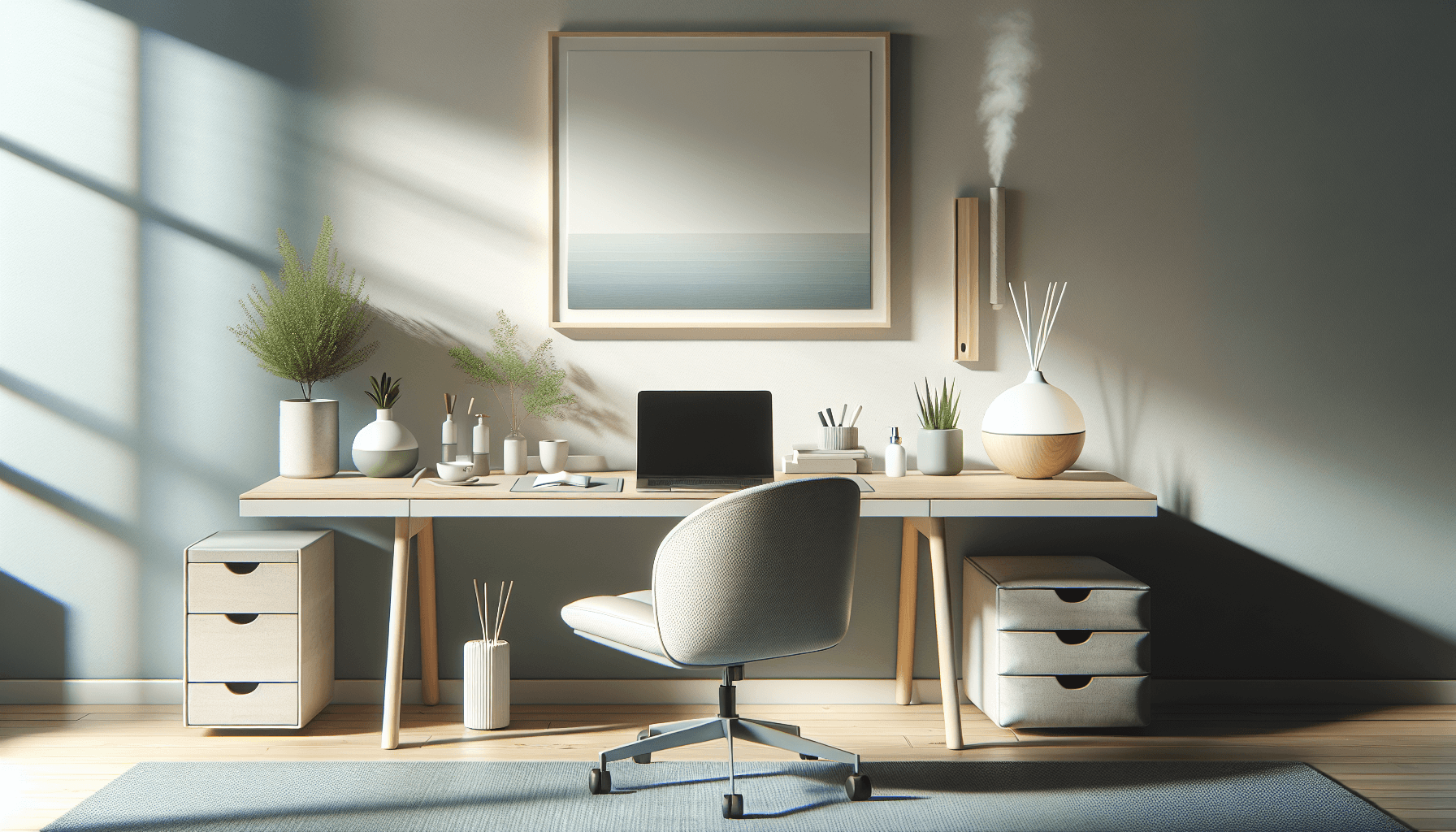Designing stress-free workspaces for enhanced calm is crucial as we spend a significant portion of our lives at work. Whether working from home or in a traditional office setting, your workspace can profoundly impact your stress levels and overall well-being.
By consciously creating an environment that promotes tranquility and efficiency, you can transform your daily work experience. The goal is not just about aesthetics but about crafting a space that supports mental wellness and productivity.
A well-designed workspace serves as a powerful tool for stress management. The right setup can boost your mood, increase focus, and even enhance creativity. This article will guide you through various strategies to make your workspace a sanctuary of calm, offering practical tips and insights along the way.
Understanding the Impact of Your Workspace on Mental Wellness
Your workspace is more than just a place to complete tasks; it plays a crucial role in your mental wellness. A cluttered or poorly designed workspace can contribute to feelings of stress and overwhelm, whereas a thoughtfully arranged space can promote a sense of calm and focus.
When your environment supports your mental health, you’re more likely to be productive and satisfied with your work. Consider how much time you spend in your workspace. For many, it’s where most waking hours are spent. Therefore, it's essential to create an environment that nurtures your mental health.
This includes everything from the physical layout to the colors and materials used. Each element of your workspace can either enhance or detract from your mental wellness. For more insights on how your environment can affect stress, explore our Manage Environmental Stressors Effectively: Top Tips.
Declutter Your Desk for a Clearer Mind
Reducing stress often begins with decluttering your desk. A cluttered desk can lead to a cluttered mind, making it difficult to concentrate and increasing anxiety. A tidy workspace can instantly make you feel more organized and in control.
Studies have shown that people with cleaner, less cluttered workspaces can focus better and process information faster than those working in more cluttered environments. This heightened focus can lead to a smoother, more productive workday.
Take time to evaluate what’s on your desk. Are there piles of papers, unused gadgets, or miscellaneous items that don’t serve a purpose? Removing unnecessary items can help clear your mind and make room for more important tasks. Keep only what you use daily within arm’s reach, and store other items away.
This simple act can significantly reduce distractions and help you focus better. For additional strategies to manage clutter, consider reading Simplified Scheduling for Stress Reduction.
Embrace Minimalism for a Calmer Environment
Embracing minimalism in your workspace can lead to a more calming environment. Minimalism isn’t about having the bare minimum; it’s about being intentional with what you keep. By reducing visual clutter, you can create an atmosphere that promotes relaxation and focus.
Minimalism can also make your workspace feel more spacious and inviting. Consider the impact of fewer objects in your field of vision. With less to distract you, your mind can focus more easily on the task at hand.
This doesn’t mean your space has to be devoid of personality. Select a few meaningful items, like a favorite photo or a small plant, to personalize your workspace without overwhelming it.
Establish Physical and Temporal Boundaries
Creating physical and temporal boundaries in your workspace is essential for maintaining a healthy work-life balance. Physical boundaries help delineate work areas from personal spaces, which is especially important when working from home.
These boundaries can prevent work from encroaching on your personal life, reducing stress and burnout. Temporal boundaries involve setting specific work hours and breaks to ensure you’re not overworking yourself.
Sticking to a schedule can help you manage your time better and reduce the temptation to work late into the night. Consistent routines can also signal to your brain when it’s time to focus and when it’s time to relax. Discover more about managing work-life balance in our article on Address Work-Life Imbalance for Stress Relief.
Incorporate Nature with Biophilic Design
Biophilic design, which incorporates elements of nature into your workspace, can significantly enhance calm and reduce stress. This can be as simple as adding plants to your desk or positioning your workspace near a window with a view of greenery.
Research has shown that exposure to nature can improve mood and increase productivity. If adding plants isn’t feasible, consider using natural materials or nature-inspired artwork. Even small changes, like using a wooden desk or hanging a picture of a scenic landscape, can make your space feel more connected to the natural world.
These elements can create a more soothing and inviting environment, making work feel less like a chore. For more insights on nature's role in stress reduction, check out Try Forest Bathing for Nature’s Stress Remedy.
Harness the Power of Natural and Artificial Light
Lighting plays a critical role in workspace design and can affect both mood and productivity. Natural light is ideal as it helps regulate your body’s natural rhythms and boosts serotonin levels, which can improve mood and focus.
If possible, position your desk near a window to take advantage of natural light. However, not every workspace has ample natural light, so artificial lighting needs to be considered. Choose lighting that mimics natural daylight to reduce eye strain and fatigue.
Avoid harsh fluorescent lights, and opt for adjustable lamps that allow you to control the brightness. The right lighting can also enhance the aesthetic of your workspace, making it more pleasant to spend time in.
Choose Colors that Promote Calm and Focus
The colors in your workspace can have a profound impact on your emotions and productivity. Cool colors like blue and green are often associated with calm and can help reduce stress. Blue is thought to enhance productivity, while green can create a sense of tranquility.
Consider using these colors in your workspace through wall paint, accessories, or artwork. Earth tones can also provide a comforting and grounding effect. Keep in mind that bright colors like red and yellow, while energizing, may be too stimulating for a workspace where concentration is key.
Balance is essential, so use colors that make you feel calm and focused. To understand more about how colors can influence your mood and stress levels, read Influence Mood Positively with Scented Candles.
The Importance of Movement and Physical Activity
Incorporating movement into your workday is crucial for reducing stress and enhancing overall well-being. Prolonged sitting can lead to physical discomfort and contribute to mental fatigue. One advantage of regular movement is that it can break up the monotony of sitting and refresh your mind.
Consider setting a timer to remind you to stand, stretch, or take a short walk every hour. Even a few minutes of physical activity can boost your energy levels and improve concentration. You might also explore using a standing desk or an exercise ball chair to encourage more movement throughout the day.
For more on using physical activity to manage stress, explore Use Physical Exercise as a Powerful Stress Reliever.
Small Changes Big Impact
Implementing small changes in your workspace can lead to significant improvements in your stress levels and productivity. You don’t need to overhaul your entire setup all at once. Start with simple adjustments, like adding a plant, decluttering your desk, or rearranging your seating to face natural light.
These small changes can accumulate over time, creating a workspace that not only looks better but also feels better to work in. Each positive change can motivate you to make more, gradually transforming your workspace into a place of calm and focus.
Conclusion
Designing a stress-free workspace is an ongoing process that involves thoughtful consideration of your environment. By understanding the impact of your workspace on mental wellness and making intentional changes, you can create a space that enhances calm and productivity.
Remember that even small adjustments can make a big difference, so start today and enjoy the benefits of a more serene and efficient work environment.






